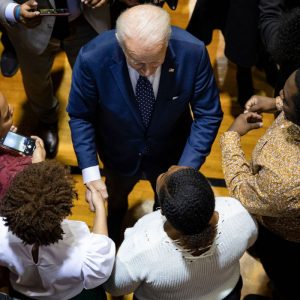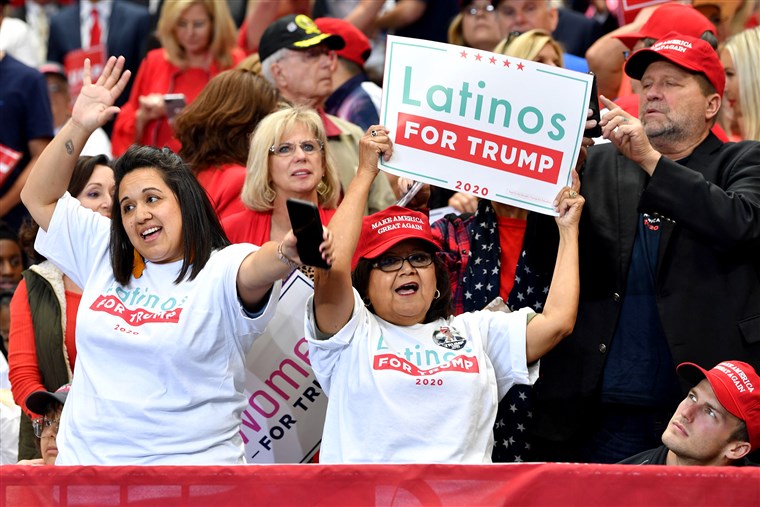Two weeks ago, I wrote of the “One Screen, Three Movies” that Americans are watching. If you’re watching the polls, the “conventional wisdom” is that Joe Biden has a solid lead over Donald Trump. And, for good reason, in that column, I urged you to ignore the polls in favor of real data.
That said, there are some polls that bear some attention. For nearly four years, M. Joseph Sheppard (@SHEPMJS on Twitter) has closely tracked six polls: Rasmussen, Democracy Institute, HarrisX, Trafalgar, Selzer, and Remington. When People’s Pundit Daily’s “Big Data” poll comes out, he includes that. Rasmussen posts nightly, except for weekends. In particular, Mike has followed Trump’s approval by blacks and Hispanics. Over a four-year period—literally with only a couple of dips (one was after Charlottesville)—Trump’s approval with blacks has ranged from 16% to 26%. On at least one occasion one of the polls had it at 28%. But then came last week. Rasmussen, on consecutive nights, had Trump at 30% and 31% black approval. Then came another shocker from a poll Sheppard does not usually track, Gravis. In Pennsylvania, even after showing Biden ahead by 3, Trump’s black approval rating was 19.8% and the “intention to vote" was equally high. The flip side of that was devastating for Joe Biden: he was only pulling 61.3% from blacks.
 To put this in perspective, Biden has yet to crack 80% approval with blacks while Hillary Clinton lost the 2016 election with 88% black approval (down markedly, of course, from Barack Obama’s 90+ numbers). A rule of thumb has been that Democrats need at least 90% of the black vote to win. If that’s the case, Biden isn’t even in the same zip code as a victory.
To put this in perspective, Biden has yet to crack 80% approval with blacks while Hillary Clinton lost the 2016 election with 88% black approval (down markedly, of course, from Barack Obama’s 90+ numbers). A rule of thumb has been that Democrats need at least 90% of the black vote to win. If that’s the case, Biden isn’t even in the same zip code as a victory.
While not the subject of this column, note that the same polls Sheppard follows have been giving Trump over 35% approval with Hispanics and in some he’s flirting with 40%. This is exceptionally high. George W. Bush supposedly got 44% with Hispanics in 2004, but many experts question that number.
With blacks, it is important to note not only how many voted for Hillary in 2016 but how many stayed home: in Florida, her black percentage was off three points from Barack Obama’s 2012 number, and there was a similar stay-at-home rate in North Carolina and Pennsylvania. In Florida, the decline in numbers of blacks voting almost by itself would have flipped the election (about 110,000 blacks to the final margin of 113,000). The tiny margin of Trump’s victory in Pennsylvania means that their black non-voters likely made the difference in that race as well.
Unless these polling numbers are as wrong as the Hoax Polls from the major organizations, Biden is in trouble. You may ask, “Schweikart, how can you cherry pick these black polls and ignore or dismiss the Trump-v-Biden polls?” It’s a good question. I think the key answer is Donald Trump. There is growing evidence that Trump voters are more committed than ever to casting a vote for Trump, yet far more reluctant to tell anyone their intention. In 2016, Trafalgar solved that with the question, “Who do you think your neighbor will vote for?” vs “Who do you plan to vote for?” But the experts at Trafalgar say even that question is not revealing the larger numbers of Trump supporters—some of whom will tell the pollster at the beginning of the interview they plan to vote for Trump but won’t say so on record.
In other words, dismissing the head-to-head polls is realistic given the incredible difficulty the pollsters are having getting the Trump supporters to “come out of the closet.” That’s not the case with black approval numbers, which is intriguing, as we may be looking at a 1936-level shift in the electorate.
Contrary to popular opinion, Franklin D. Roosevelt did not win the majority of black voters in 1932. Those still went to Herbert Hoover. As Mike’s son, Si Sheppard has written in The Buying of the Presidency? ward after ward, precinct after precinct shifted to FDR in 1936. In Chicago, for example, FDR had won only 21% of the black vote in 1932 but got 48.8% four years later. I’ll leave it to Si Sheppard to explain what caused the shift, but for our purposes, it is important to understand that a 50% shift in a single election cycle has been done before.
My own take on the numbers is that Trump, with 8% in 2016, really had closer to 10% if you count the stay-at-homes as a “half-Trump” vote. During the 2016 election cycle, he never remotely approached 25% black approval in polls. But now we have four years of Trump consistently being over 16%. This is what I call the Trump Three Step. In 2016, 8% voted for him, but another 3% stayed home. In 2020, I think that 3% at a minimum will vote for him (bringing him to around 12%) while still another 5-8% stay home. The net real impact of this would be anywhere from 14.5% to 16% genuine net Trump vote.
Those voters still aren’t sold on “Republicans” in general though. Trump is sui generis. That is why I think Republicans as a whole cannot count on a higher black vote for Trump as benefiting them. (There are exceptions: Rick Scott and Ron DeSantis in Florida come to mind). The third and final “step” will be for those who vote for Trump to pull the lever for all Republicans down-ticket.
On top of all this, you have the Kanye factor. It is unclear right now whether he is serious in his run, but he has made it clear one of his main objectives is not to defeat Donald Trump but to take votes from Joe Biden. If Biden falls below 75% in black support, the ripples could stretch all the way through the political scene. Close House and Senate races won’t be close. If Kanye is still in the race on election day, it would not be unexpected for him to draw another 1-2% away from Biden.
In short, the consistent four-year polling of black approval numbers is not affected by the “shy Trump” factor. I think they are real. The only question remains is whether 21% approval can translate into 21% actual votes. Because if it’s even remotely in that ballpark, there aren’t enough suburban Karens in the world to save the Democrat Party in November.
Larry Schweikart is the co-author with Michael Allen of the New York Times #1 bestseller, A Patriot’s History of the United States, the author of Reagan: The American President, and the founder of the Wild World of History, a history curriculum website for teachers and homeschoolers (www.wildworldofhistory.com).






